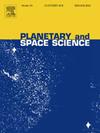Precision in planetary exploration: Crater detection with residual U-Net34/50 and matching template algorithm
IF 1.7
4区 物理与天体物理
Q3 ASTRONOMY & ASTROPHYSICS
引用次数: 0
Abstract
Counting craters on celestial bodies such as the Moon is essential for understanding the Solar System's evolution and its dynamic past. The conventional crater recognition methods rely heavily on human observation, often paired with standard machine learning techniques. However, these methods face obstacles, like the absence of an objective criterion and challenges in achieving accurate recognition results for overlapping or smaller craters. To mitigate these issues, our proposed solution involves implementing a convolutional neural network known as the Residual U-Net-34 and Residual U-Net-50. These models are designed to effectively identify craters within lunar Digital Elevation Model (DEM) images. The initial step of our method involves the emphasizing of crater edges and suppressing the other surfaces within lunar DEM data. Following edge detection, we employ matching template algorithm to calculate the size and positions of craters within the lunar DEM data. In the Residual U-Net-34 and Residual U-Net-50 architectures, the framework extends the U-Net model by incorporating the residual convolution block, departing from conventional convolution methods. This hybridization leverages the strengths of both U-Net and residual networks. Remarkably, Residual U-Net-34 and Residual U-Net-50 maintains the input and output image sizes, simplifying the training process due to its use of residual units. This design also enables straightforward optimization of the proposed model. The approach focuses on crater rims and demonstrates the ability to identify overlapping craters. Within the domain of lunar crater recognition, our model demonstrates elevated performance with a recall of 77.22% and precision of 83.67% when operating on DEM data. Notably, the recall and precision outperform other deep learning methods. These experimental outcomes validate the feasibility of leveraging our network for crater recognition within lunar DEM datasets.
行星探测精度:残差U-Net34/50和匹配模板算法的陨石坑探测
对月球等天体上的陨石坑进行计数,对于了解太阳系的演化及其动态的过去至关重要。传统的陨石坑识别方法严重依赖于人类观察,通常与标准的机器学习技术相结合。然而,这些方法面临着障碍,如缺乏客观标准,以及在获得重叠或较小的陨石坑的准确识别结果方面存在挑战。为了缓解这些问题,我们提出的解决方案涉及实现一个称为残余U-Net-34和残余U-Net-50的卷积神经网络。这些模型旨在有效地识别月球数字高程模型(DEM)图像中的陨石坑。该方法的初始步骤包括在月球DEM数据中强调陨石坑边缘并抑制其他表面。在边缘检测之后,我们使用匹配模板算法计算月球DEM数据中陨石坑的大小和位置。在残差U-Net-34和残差U-Net-50体系结构中,该框架通过加入残差卷积块来扩展U-Net模型,与传统的卷积方法不同。这种混合利用了U-Net和剩余网络的优势。值得注意的是,残余U-Net-34和残余U-Net-50保持了输入和输出图像的大小,由于使用了残差单元,简化了训练过程。这种设计还可以直接优化所提出的模型。该方法侧重于陨石坑边缘,并展示了识别重叠陨石坑的能力。在月球陨石坑识别领域,模型在DEM数据上的查全率和查准率分别达到77.22%和83.67%。值得注意的是,召回率和准确率优于其他深度学习方法。这些实验结果验证了利用我们的网络在月球DEM数据集中进行陨石坑识别的可行性。
本文章由计算机程序翻译,如有差异,请以英文原文为准。
求助全文
约1分钟内获得全文
求助全文
来源期刊

Planetary and Space Science
地学天文-天文与天体物理
CiteScore
5.40
自引率
4.20%
发文量
126
审稿时长
15 weeks
期刊介绍:
Planetary and Space Science publishes original articles as well as short communications (letters). Ground-based and space-borne instrumentation and laboratory simulation of solar system processes are included. The following fields of planetary and solar system research are covered:
• Celestial mechanics, including dynamical evolution of the solar system, gravitational captures and resonances, relativistic effects, tracking and dynamics
• Cosmochemistry and origin, including all aspects of the formation and initial physical and chemical evolution of the solar system
• Terrestrial planets and satellites, including the physics of the interiors, geology and morphology of the surfaces, tectonics, mineralogy and dating
• Outer planets and satellites, including formation and evolution, remote sensing at all wavelengths and in situ measurements
• Planetary atmospheres, including formation and evolution, circulation and meteorology, boundary layers, remote sensing and laboratory simulation
• Planetary magnetospheres and ionospheres, including origin of magnetic fields, magnetospheric plasma and radiation belts, and their interaction with the sun, the solar wind and satellites
• Small bodies, dust and rings, including asteroids, comets and zodiacal light and their interaction with the solar radiation and the solar wind
• Exobiology, including origin of life, detection of planetary ecosystems and pre-biological phenomena in the solar system and laboratory simulations
• Extrasolar systems, including the detection and/or the detectability of exoplanets and planetary systems, their formation and evolution, the physical and chemical properties of the exoplanets
• History of planetary and space research
 求助内容:
求助内容: 应助结果提醒方式:
应助结果提醒方式:


